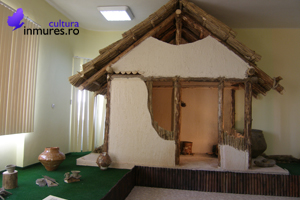
The Archaeological Exhibition
The territory of the Mureș county is very rich in archaeological vestiges. As early as 1882, historian Farkas Deak and priest Ferenc Kovacs made archaeological digs in Cristesti and uncovered the remains of a former Roman settlement. Based on these digs, the priest assembled a collection of archaeological materials that would become part of the future museum established by Aurel Filimon during the inter-war era. Another collector of archaeological vestiges active before the establishment of an actual museum was Domokos Teleki of Gornești. The official date of establishment of the Tîrgu-Mureș museum is May 1, 1921, when Aurel Filimon organized an exhibition of archaeology and ethnography in two halls of the Palace of Culture and was appointed custodian. Filimon was a passionate collector, interested in folklore and ethnography, archaeology, as well as natural sciences. He acquired his expertise as an archaeologist between 1914 – 1917 working as an assistant and secretary of Alexandru Tzigara Samurcaș, the manager of the National Museum of Art and Ethnography of Bucharest. As soon as he started working as a librarian in Tîrgu Mureș, in 1918, he took steps toward the establishment of a museum. The sections that would develop under his management were the history, archaeology and ethnography-folk art. As for his rich natural sciences collection, it was destroyed during the Second World War. As custodian of the Museum, he participated in several archaeological digs throughout the county. The archaeological items he unearthed were a welcomed addition to the museum”™s collection, enhancing it both in quantity and in quality. Following the digs of Cristesti, where a Roman settlement rich in vestiges had been unearthed, and those of Suseni that brought to light the famous fibula from the bronze age, it became more and more obvious that a permanent exhibition was needed in the museum. The arguments of Filimon in this regard referred to the necessity of involving cultural institutions in the educational process, which was only possible through interactions with the public. The first permanent exhibition was opened in 1934 in the Palace of Culture. Currently the storage areas of the museum include an impressive number of objects: tools, weapons, ceramic vases, jewellery, coins, dating from the prehistoric age to the present. Among the most important items is the bronze fibula of Suseni which became the emblem of the Mureș County Museum or the marble sculpture representing the head of goddess Junona discovered in the archaeological site of Cristești. Many of these items can be found in the current exhibition entitled "Habitat in the Valley of the Upper Mureș". It was set up in 2007 with the financial aid of the Administration of the National Cultural Fund and is more than a simple exhibition of items, as it reconstitutes essential moments of the daily life, starting from the Neolithic age and up to the age of migrations. The exhibition methods are more dynamic and interactive.
Bibliography:
Valer Pop- Muzeograful în vol. "Aurel Filimon – consacrare și destin", volume published by Mureș County Library and the "Vasile Netea" Cultural Foundation, Tîrgu-Mureș, 2001, pp. 73-80.
Traina Dușa, Pagini de istorie,artă și cultură, Vol II, Ed. Ansid, Tîrgu-Mureș, 2002, pp. 16-36.

